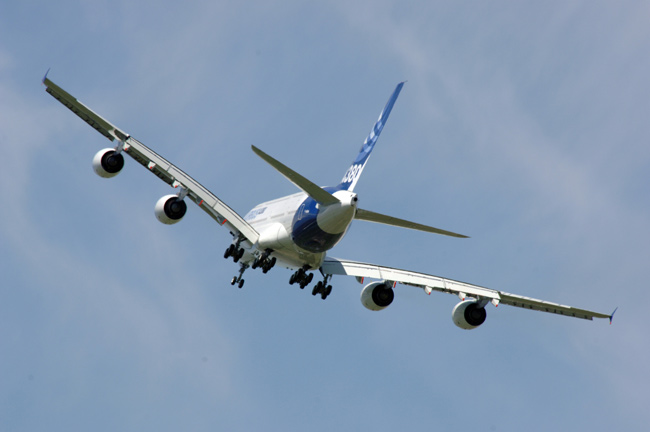Europe Launches New Aviation Research Program

European Unionadministrators will provide official funding for a group of 36 researchprojects that they believe will help make air transport greener, safer, moresecure and more cost-efficient.
The fourlarge and 32 smaller projects to be funded will research key areas such as usingflight physics and alternative fuels to reducecarbon dioxide (CO2) emissions for aircraft, and developing new systems to improveaircraft safety in bad weather.
Researcherswill also work on developing aircraftmaterials that can repair themselves, and creating blast-proof aircraftcabin structures. Other projects will seek ways of reducing production anddevelopment costs for airframes, aircraft structures, engines and components.
TheEuropean Commission (the European Union's administrative body) received 196proposals after issuing a call earlier this year for research proposals inaeronautics and air transport. It short-listed 89 of them, from whichindependent evaluators then selected the 36 most promising proposals to receivefunding.
"Severalof the selected projects will work towards the EU's goals of halving carbonemissions per passenger kilometer by 2020," said Janez Potočnik, theEuropean Union's (EU) Research Commissioner.
All of theprojects are expected to start in January 2008.
The EU isfunding them under its Seventh Framework Program for Research (FP7), which willmake available a total of euros2.1 billion ($2.98 billion) for aeronauticsresearch in the period from 2007 to 2013. The first batch of 36 projects nowselected will receive euros217 million ($308 million).
Get the Space.com Newsletter
Breaking space news, the latest updates on rocket launches, skywatching events and more!
Four largeprojects
Almost halfof the $308 million will go to four large projects. Each will be led by a majorair transport industry manufacturer and each is intended to pursue the dualgoals of reinforcing Europe's industrial leadership and responding to aviationenvironmental and safety concerns.
The four largeprojects are:
- DREAM, a project more formally known as Validation of Radical Engine Architecture Systems. Led by Rolls-Royce and involving 47 partners from 13 countries, DREAM will develop new engine concepts based on open, contra-rotating rotors. It is targeting a 7 percent reduction in CO2 emissions and a 3-decibel reduction in noise. The project will also develop specifications for alternate fuels, and will assess and test potential future fuels. The EU will provide euros25 million ($35.6 million) in funding for DREAM.
- MAAXIMUS, an acronym for "More Affordable Aircraft Structure through Extended, Integrated and Mature Numerical Sizing." This project has 58 partners from 18 countries and is led by Airbus. It aims to improve the composition and design of aircraft fuselages, in order to cut assembly time in half and to reduce structural weight by 10 percent, which in turn would reduce CO2 emissions. MAAXIMUS will receive euros40 million ($57 million) of EU funding.
- HIRF SE, which stands for High Intensity Radiated Field Synthetic Environment. Involving 44 partners from 11 countries under the leadership of Alenia, this project will create simulators to test the reaction of new aircraft to electromagnetic interference. This area of research is particularly important because of the growing use of composite materials in aircraft. The EU will provide euros18 million ($25.7 million) for HIRF SE.
- SCARLETT, a project led by Thales to develop advanced modular avionics platforms for a range of aircraft types. SCARLETT will receive euros23 million ($32.8 million) of EU research funding.
Otherprojects will conduct research into areas such as extreme icing environments;biofuels for aviation use; future avionics architecture for small-aircraft;smart high-lift devices for next-generation wings; blast-worthy textile-basedluggage containers; flutter-free turbomachinery blades; and long-term advancedpropulsion concepts.
High-techsafety systems
One projectcalled HISVESTA and headed by Norwegian institute SINTEF aims to develophigh-stability altimeters to produce very accurate measurements of thevertical-distance separations between aircraft.
Suchinstruments could be particularly useful for aircraft in densely traffickedhigh-altitude airspace -- such as busy transatlantic airways, which aren?tradar-controlled -- where reduced vertical separation minimum (RVSM) rules arein effect. RVSM procedures allow the vertical separation between aircraft atcruise altitudes to be 1,000 feet, instead of the formerly standard 2,000 feet.Because the vertical separation in RVSM airspace has been cut in half, aircraftusing it must have extremely accurate navigation equipment and flightinstruments installed.
Two otherprojects will be based on the use of laser technologies. One will demonstrate alaser-based anemometer (an instrument that measures wind speed), while theother will demonstrate a wake vortex detection system based on LIDAR (lightdetection and ranging) that will work in atmospheric haze.
Aircraftwake-vortex turbulence is becoming an increasingly important area of research forthe air transport industry with the advent of the huge Airbus A380 and therapidly increasing number of large widebody aircraft at major airports. Amongthe 32 smaller projects to be funded by the EU are six "coordinationactions," aimed at stimulating the participation of small- andmedium-sized companies and new EU member states in air transport research. Oneof the six coordination actions will concentrate on the issue of aircraft waketurbulence, under the leadership of Airbus Deutschland.
Join our Space Forums to keep talking space on the latest missions, night sky and more! And if you have a news tip, correction or comment, let us know at: community@space.com.
Chris Kjelgaard has more than 40 years of experience writing about and consulting on the civil aviation industry, aerospace and travel. He was a senior editor of Aviation.com from 2007-2008, and now works as a freelance writer and consultant in the aviation industry. He holds a B.S. in genetics from The University of Edinburgh.









